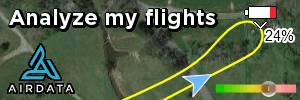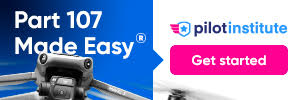Statement: "I don't see a prohibition against a switch to
enable RID, with no
disable function?"
Response: "Please tell me how a switch to
disable RID in a standard RID drone permits you to comply with the regulation."
Consider a software switch that's sole function is to allow the operator to
switch on RID when flying a
Mini 4 Pro with a standard battery.
Sure I get your point now. I am assuming there is no function to switch RID to OFF so I'll address your question like this:
The purpose would be to allow the
Mini 4 Pro with a standard battery installed to fly by default with RID turned OFF but should the pilot decide to transmit RID (for whatever reason), there is a manual software switch which could be toggled by the pilot to the ON position. There is no OFF (or disable) position and when the extended battery is inserted, the option is grey-out because RID is ON (or enabled) and cannot be disabled meaning no changes can be made by the pilot.
No issue with that but IMO, here's the problem:
The
Mini 4 Pro (and its relevant serial numbers) has a DOC for Standard Remote ID and it was designed to be a standard RID drone. In 89.110 we are told what we need to do in order to legally operate the
Mini 4 Pro.
So that means according to Subpart F, which prescribes the requirements for design and production for RID for US operations, you get an exception for a 0.55lb or less drone unless you are a drone designed and produced to be a standard RID drone (not remote broadcast RID). Without that exception, you need to comply with 89.305 (not 89.310) specifically:
Primarily the self-testing clause and secondarily the tamper resistance clause. Unless the drone automatically checks for RID and appropriately prevents takeoff....and a manual software switch
technically permits the pilot to tamper (good or bad) with the RID functionality.
So, unless I am wrong, I don't see how a drone can be a
standard remote identification unmanned aircraft but rely on any of the rules for
remote identification broadcast modules when it comes to complying with Part 89 especially when it says "A person operating an unmanned aircraft that is
not a standard remote identification unmanned aircraft may comply with the remote identification requirement...." It's not an either/or, the broadcast module is the exception to the rule. I could be wrong but personally, I believe it is done this way so that manufacturers cannot just forgo the standard RID, keep making and selling large drones going forward, and then asking the buyer/pilot to provide their own solution (broadcast module) if they want to legally fly.
I just threw this out there, I could be way off base. The FAA rules and regulations aren't always consistent, often not very clear, and sometimes confusing as to what is the law, what is a suggestion, who's responsible for what, etc. IANAL.
PART 89—REMOTE IDENTIFICATION OF UNMANNED AIRCRAFT
Authority:
49 U.S.C. 106(f),
106(g),
40101(d),
40103(b),
44701,
44805,
44809(f); Section 2202 of
Pub. L. 114-190, 130 Stat. 629.
Source:Amdt. 89-1,
86 FR 4505, Jan. 15, 2021, unless otherwise noted.
Subpart A—General
§ 89.1 Definitions.
The following definitions apply to this part.
Declaration of compliance means a record submitted to the FAA by the producer of a standard remote identification unmanned aircraft or remote identification broadcast module to attest that all the requirements of
subpart F of this parthave been met.
Home-built unmanned aircraft means an unmanned aircraft that an individual built solely for education or recreation.
§ 89.5 Falsification, reproduction, alteration, or omission.
(a) No person may make or cause to be made any of the following:
(1) Any fraudulent or intentionally false statement in any document related to any acceptance, application, approval, authorization, certificate, declaration, designation, qualification, record, report, request for reconsideration, or similar, submitted under this part.
(2) Any fraudulent or intentionally false statement in any document required to be developed, provided, kept, or used to show compliance with any requirement under this part.
(3) Any reproduction or alteration, for fraudulent purpose, of any document related to any acceptance, application, approval, authorization, certificate, declaration, designation, qualification, record, report, request for reconsideration, or similar, submitted or granted under this part.
(b) No person may, by omission, knowingly conceal or cause to be concealed, a material fact in—
(1) Any document related to any acceptance, application, approval, authorization, certificate, declaration, designation, qualification, record, report, request for reconsideration, or similar, submitted under this part; or
(2) Any document required to be developed, provided, kept, or used to show compliance with any requirement under this part.
(c) The commission by any person of an act prohibited under
paragraph (a) or
(b) of this section is a basis for—
(1) Denial, suspension, rescission, or revocation of any acceptance, application, approval, authorization, certificate, declaration, declaration of compliance, designation, document, filing, qualification, means of compliance, record, report, request for reconsideration, or similar instrument issued or granted by the Administrator and held by that person; or
(2) A civil penalty.
Subpart B—Operating Requirement
§ 89.101 Applicability.
(a) Except as provided in
paragraph (b) of this section, this subpart applies to the following:
(1) Persons operating unmanned aircraft registered or required to be registered under
part 47 or
48 of this chapter.
(2) Persons operating foreign civil unmanned aircraft in the United States.
(b) This subpart does not apply to unmanned aircraft operations under
part 91 of this chapter that are transmitting ADS-B Out pursuant to
§ 91.225.
§ 89.105 Remote identification requirement.
Except as otherwise authorized by the Administrator or as provided in
§ 89.120, after September 16, 2023, no person may operate an unmanned aircraft within the airspace of the United States unless the operation meets the requirements of
§ 89.110 or
§ 89.115.
§ 89.110 Operation of standard remote identification unmanned aircraft.
Unless otherwise authorized by the Administrator, a person may comply with the remote identification requirement of
§ 89.105 by operating a standard remote identification unmanned aircraft under the following conditions:
(a)
Operational requirements. A person may operate a standard remote identification unmanned aircraft only if the person operating the standard remote identification unmanned aircraft ensures that all of the following conditions are met:
(1) From takeoff to shutdown, the standard remote identification unmanned aircraft must broadcast the message elements of
§ 89.305.
(2) The person manipulating the flight controls of the unmanned aircraft system must land the unmanned aircraft as soon as practicable if the standard remote identification unmanned aircraft is no longer broadcasting the message elements of
§ 89.305.
(b)
Standard remote identification unmanned aircraft requirements. A person may operate a standard remote identification unmanned aircraft only if the unmanned aircraft meets all of the following requirements:
(1) Its serial number is listed on an FAA-accepted declaration of compliance, or the standard remote identification unmanned aircraft is covered by a design approval or production approval issued under
part 21 of this chapter and meets the requirements of
subpart F of this part.
(2) Its remote identification equipment is functional and complies with the requirements of this part from takeoff to shutdown.
(3) Its remote identification equipment and functionality have not been disabled.
(4) The Certificate of Aircraft Registration of the unmanned aircraft used in the operation must include the serial number of the unmanned aircraft, as per applicable requirements of
parts 47 and
48 of this chapter, or the serial number of the unmanned aircraft must be provided to the FAA in a notice of identification pursuant to
§ 89.130prior to the operation.
§ 89.115 Alternative remote identification.
A person operating an unmanned aircraft that is not a standard remote identification unmanned aircraft may comply with the remote identification requirement of
§ 89.105 by meeting all of the requirements of either
paragraph (a) or
(b)of this section.
(a)
Remote identification broadcast modules. Unless otherwise authorized by the Administrator, a person may operate an unmanned aircraft that is not a standard remote identification unmanned aircraft if all of the following conditions are met:
(1)
Equipage.
(i) The unmanned aircraft used in the operation must be equipped with a remote identification broadcast module that meets the requirements of
§ 89.320 and the serial number of the remote identification broadcast module must be listed on an FAA-accepted declaration of compliance.
(ii) The Certificate of Aircraft Registration of the unmanned aircraft used in the operation must include the serial number of the remote identification broadcast module, as per applicable requirements of
parts 47 and
48 of this chapter, or the serial number of the unmanned aircraft must be provided to the FAA in a notice of identification pursuant to
§ 89.130 prior to the operation.
(2)
Remote identification operating requirements. Unless otherwise authorized by the Administrator, a person may operate an unmanned aircraft under this
paragraph (a) only if all of the following conditions are met:
(i) From takeoff to shutdown, the person operating the unmanned aircraft must ensure that the remote identification broadcast module broadcasts the remote identification message elements of
§ 89.315 directly from the unmanned aircraft.
(ii) The person manipulating the flight controls of the unmanned aircraft system must be able to see the unmanned aircraft at all times throughout the operation.
(3)
Pre-flight requirement. Prior to takeoff, the person manipulating the flight controls of the unmanned aircraft system must ensure the remote identification broadcast module is functioning in accordance with this subpart.
(4)
In-flight loss of remote identification broadcast. The person manipulating the flight controls of the unmanned aircraft system must land the unmanned aircraft as soon as practicable if the unmanned aircraft is no longer broadcasting the message elements of
§ 89.315.
(b)
Operations at FAA-recognized identification areas. Unless otherwise authorized by the Administrator, a person may operate an unmanned aircraft without remote identification equipment only if all of the following conditions are met:
(1) The unmanned aircraft and the person manipulating the flight controls of the unmanned aircraft system remain within the boundaries of an FAA-recognized identification area throughout the operation; and
(2) The person manipulating the flight controls of the unmanned aircraft system must be able to see the unmanned aircraft at all times throughout the operation.
§ 89.120 Operations for aeronautical research or to show compliance with regulations.
The Administrator may authorize operations without remote identification where the operation is solely for the purpose of aeronautical research or to show compliance with regulations.
§ 89.125 Automatic Dependent Surveillance-Broadcast (ADS-B) Out prohibition.
Automatic Dependent Surveillance-Broadcast (ADS-B) Out equipment cannot be used to comply with the remote identification requirements of this part.
§ 89.130 Confirmation of identification.
(a)
Notification requirement. No person may operate a foreign registered civil unmanned aircraft with remote identification in the airspace of the United States unless, prior to the operation, the person submits a notice of identification in a form and manner acceptable to the Administrator. The notice of identification must include all of the following:
(1) The name of the person operating the foreign registered civil unmanned aircraft in the United States, and, if applicable, the person's authorized representative.
(2) The physical address of the person operating the foreign registered civil unmanned aircraft in the United States, and, if applicable, the physical address for the person's authorized representative. If the operator or authorized representative does not receive mail at the physical address, a mailing address must also be provided.
(3) The telephone number(s) where the person operating the foreign registered civil unmanned aircraft in the United States, and, if applicable, the person's authorized representative can be reached while in the United States.
(4) The email address of the person operating the foreign registered civil unmanned aircraft in the United States, and, if applicable, the email address of the person's authorized representative.
(5) The unmanned aircraft manufacturer and model name.
(6) The serial number of the unmanned aircraft or remote identification broadcast module.
(7) The country of registration of the unmanned aircraft.
(8) The registration number.
(b)
Issuance of a Confirmation of Identification.
(1) The FAA will issue a Confirmation of Identification upon completion of the notification requirements provided in
paragraph (a) of this section.
(2) The filing of a notification under
paragraph (a) of this section and the Confirmation of Identification issued under
paragraph (b)(1) of this section do not have the effect of United States aircraft registration.
(c)
Proof of notification. No person may operate a foreign registered civil unmanned aircraft with remote identification in the United States unless the person obtains a Confirmation of Identification under
paragraph (b)(1) of this section, maintains such Confirmation of Identification at the unmanned aircraft's control station, and produces the Confirmation of Identification when requested by the FAA or a law enforcement officer.
(d)
Requirement to maintain current information. The holder of a Confirmation of Identification must ensure that the information provided under
paragraph (a) of this section remains accurate and must update the information prior to operating a foreign registered civil unmanned aircraft in the United States.
Subpart C—FAA-Recognized Identification Areas
Source:Amdt. 89-1,
86 FR 4511, Jan. 15, 2021, unless otherwise noted.
§ 89.201 Applicability.
This subpart prescribes procedural requirements to establish an FAA-recognized identification area.
§ 89.205 Eligibility.
Only the following persons are eligible to apply for the establishment of an FAA-recognized identification area under this subpart:
(a) A community-based organization recognized by the Administrator.
(b) An educational institution, including primary and secondary educational institutions, trade schools, colleges, and universities.
§ 89.210 Requests for establishment of an FAA-recognized identification area.
(a)
Application. An eligible person requesting the establishment of an FAA-recognized identification area under this subpart may submit an application in a form and manner acceptable to the Administrator.
(b)
Required documentation. A request under this subpart must contain all of the following information:
(1) The name of the eligible person under
§ 89.205.
(2) The name of the individual making the request on behalf of the eligible person.
(3) A declaration that the individual making the request has the authority to act on behalf of the community-based organization or educational institution.
(4) The name and contact information of the primary point of contact for communications with the FAA.
(5) The physical address of the proposed FAA-recognized identification area.
(6) The location of the proposed FAA-recognized identification area in a form and manner prescribed by the Administrator.
(7) If applicable, a copy of any existing letter of agreement regarding the flying site.
(8) Description of the intended purpose of the FAA-recognized identification area and why the proposed FAA-recognized identification area is necessary for that purpose.
(9) Any other information required by the Administrator.
§ 89.215 Approval of FAA-recognized identification areas.
The Administrator will assess applications for FAA-recognized identification areas and may require additional information or documentation, as needed, to supplement an application. The Administrator will approve or deny an application, and may take into consideration matters such as, but not limited to:
(a) The existence of any FAA established flight or airspace restriction limiting the operation of unmanned aircraft systems, such as special use airspace designations under
part 73 of this chapter, temporary flight restrictions issued under
part 91 of this chapter, or any other special flight rule, restriction or regulation in this chapter limiting the operation of unmanned aircraft systems in the interest of safety, efficiency, national security and/or homeland security, which overlaps with the proposed FAA-recognized identification area.
(b) The safe and efficient use of airspace by other aircraft.
(c) The safety and security of persons or property on the ground.
(d) The need for an FAA-recognized identification area in the proposed location and proximity of other FAA-recognized identification areas.
§ 89.220 Amendment.
(a) From the time of application until expiration or termination of an FAA-recognized identification area, any change to the information submitted in the application including but not limited to a change to the point of contact for the FAA-recognized identification area or a change to the FAA-recognized identification area's organizational affiliation must be submitted to the FAA within 10 calendar days of the change.
(b) If the person who has been granted an FAA-recognized identification area wishes to change the geographic boundaries of the FAA-recognized identification area, the person must submit a request describing the change to the FAA for review. The geographic boundaries of the FAA-recognized identification area will not change unless the requested change is approved in accordance with
§ 89.215.
(c) The establishment of an FAA-recognized identification area is subject to ongoing review in accordance with
§ 89.215 by the Administrator that may result in the termination of the FAA-recognized identification area pursuant to
§ 89.230 or modification of the FAA-recognized identification area.
§ 89.225 Duration of an FAA-recognized identification area.
(a)
Duration. Except as otherwise provided in this subpart, an FAA-recognized identification area will be in effect for 48 calendar months after the date the FAA approves the request for establishment of an FAA-recognized identification area.
(b)
Renewal. A person wishing to renew an FAA-recognized identification area must submit a request for renewal no later than 120 days prior to the expiration of the FAA-recognized identification area in a form and manner acceptable to the Administrator. The Administrator may deny requests submitted after that deadline or requests submitted after the expiration.
§ 89.230 Expiration and termination.
(a)
Expiration. Unless renewed, an FAA-recognized identification area issued under this subpart will expire automatically and will have no further force or effect as of the day that immediately follows the date of expiration.
(b)
Termination prior to expiration —
(1)
Termination by request. An individual identified as the point of contact for an approved FAA-recognized identification area may submit a request to the Administrator to terminate that FAA-recognized identification area.
(2)
Termination by FAA.
(i) The FAA may terminate an FAA-recognized identification area upon a finding that—
(A) The FAA-recognized identification area may pose a risk to aviation safety, public safety, homeland security, or national security;
(B) The FAA-recognized identification area is no longer associated with a person eligible for an FAA-recognized identification area; or
(C) The person who submitted a request for establishment of an FAA-recognized identification area provided false or misleading information during the submission, amendment, or renewal process.
(ii) The Administrator will notify the primary point of contact of the decision to terminate the FAA-recognized identification area and the reasons for the termination. Except as provided in
paragraph (c) of this section, if the FAA terminates an FAA-recognized identification area based upon a finding that the FAA-recognized identification area may pose a risk to aviation safety, public safety, homeland security, or national security, that area will no longer be eligible to be an FAA-recognized identification area for as long as those conditions remain in effect.
(c)
Petition to reconsider the FAA's decision to terminate an FAA-recognized identification area. No later than 30 calendar days after the termination of an FAA-recognized identification area, a person may petition the Administrator for reconsideration of the decision. The petition must state the reasons justifying the request for reconsideration and include any supporting documentation. Upon consideration of the information submitted by the petitioner, the Administrator will notify the petitioner of the decision on the request for reconsideration.
(d)
Inapplicability of part 13, subpart D, of this chapter. Part 13, subpart D, of this chapter does not apply to the procedures of
paragraphs (b) and
(c) of this section.
Subpart D—Requirements for Standard Remote Identification Unmanned Aircraft and Remote Identification Broadcast Modules
§ 89.301 Applicability.
This subpart prescribes the minimum message element set and minimum performance requirements for standard remote identification unmanned aircraft and remote identification broadcast modules.
§ 89.305 Minimum message elements broadcast by standard remote identification unmanned aircraft.
A standard remote identification unmanned aircraft must be capable of broadcasting the following remote identification message elements:
(a) The identity of the unmanned aircraft, consisting of:
(1) A serial number assigned to the unmanned aircraft by the person responsible for the production of the standard remote identification unmanned aircraft; or
(2) A session ID.
(b) An indication of the latitude and longitude of the control station.
(c) An indication of the geometric altitude of the control station.
(d) An indication of the latitude and longitude of the unmanned aircraft.
(e) An indication of the geometric altitude of the unmanned aircraft.
(f) An indication of the velocity of the unmanned aircraft.
(g) A time mark identifying the Coordinated Universal Time (UTC) time of applicability of a position source output.
(h) An indication of the emergency status of the unmanned aircraft.
§ 89.310 Minimum performance requirements for standard remote identification unmanned aircraft.
A standard remote identification unmanned aircraft must meet the following minimum performance requirements:
(a)
Control station location. The location of the control station of the unmanned aircraft must be generated and encoded into the message elements and must correspond to the location of the person manipulating the flight controls of the unmanned aircraft system.
(b)
Time mark. The time mark message element must be synchronized with all other remote identification message elements.
(c) Self-testing and monitoring.
(1) Prior to takeoff, the unmanned aircraft must automatically test the remote identification functionality and notify the person manipulating the flight controls of the unmanned aircraft system of the result of the test.
(2) The unmanned aircraft must not be able to take off if the remote identification equipment is not functional.
(3) The unmanned aircraft must continuously monitor the remote identification functionality from takeoff to shutdown and must provide notification of malfunction or failure to the person manipulating the flight controls of the unmanned aircraft system.
(d) Tamper resistance. The unmanned aircraft must be designed and produced in a way that reduces the ability of a person to tamper with the remote identification functionality.
(e)
Error correction. The remote identification equipment must incorporate error correction in the broadcast of the message elements in
§ 89.305.
(f)
Interference considerations. The remote identification equipment must not interfere with other systems or equipment installed on the unmanned aircraft, and other systems or equipment installed on the unmanned aircraft must not interfere with the remote identification equipment.
(g)
Message broadcast.
(1) The unmanned aircraft must be capable of broadcasting the message elements in
§ 89.305 using a non-proprietary broadcast specification and using radio frequency spectrum compatible with personal wireless devices in accordance with
47 CFR part 15, where operations may occur without an FCC individual license.
(2) Any broadcasting device used to meet the requirements of this section must be integrated into the unmanned aircraft without modification to its authorized radio frequency parameters and designed to maximize the range at which the broadcast can be received, while complying with
47 CFR part 15 and any other applicable laws in effect as of the date the declaration of compliance is submitted to the FAA for acceptance.
(h)
Message elements performance requirements.
(1) The reported geometric position of the unmanned aircraft and the control station must be accurate to within 100 feet of the true position, with 95 percent probability.
(2) The reported geometric altitude of the control station must be accurate to within 15 feet of the true geometric altitude, with 95 percent probability.
(3) The reported geometric altitude of the unmanned aircraft must be accurate to within 150 feet of the true geometric altitude, with 95 percent probability.
(4) The unmanned aircraft must broadcast the latitude, longitude, and geometric altitude of the unmanned aircraft and its control station no later than 1.0 seconds from the time of measurement to the time of broadcast.
(5) The unmanned aircraft must broadcast the message elements at a rate of at least 1 message per second.
(i)
Take-off limitation. The unmanned aircraft must not be able to take off unless it is broadcasting the message elements in
§ 89.305.
§ 89.315 Minimum message elements broadcast by remote identification broadcast modules.
Remote identification broadcast modules must be capable of broadcasting the following remote identification message elements:
(a) The identity of the unmanned aircraft, consisting of the serial number assigned to the remote identification broadcast module by the person responsible for the production of the remote identification broadcast module.
(b) An indication of the latitude and longitude of the unmanned aircraft.
(c) An indication of the geometric altitude of the unmanned aircraft.
(d) An indication of the velocity of the unmanned aircraft.
(e) An indication of the latitude and longitude of the take-off location of the unmanned aircraft.
(f) An indication of the geometric altitude of the take-off location of the unmanned aircraft.
(g) A time mark identifying the Coordinated Universal Time (UTC) time of applicability of a position source output.
§ 89.320 Minimum performance requirements for remote identification broadcast modules.
Remote identification broadcast modules must meet the following minimum performance requirements:
(a)
Take-off location. The remote identification broadcast module must be capable of determining the take-off location of the unmanned aircraft.
(b)
Time mark. The time mark message element must be synchronized with all other remote identification message elements.
(c)
Self-testing and monitoring.
(1) Prior to take-off, the remote identification broadcast module must automatically test the remote identification functionality and notify the person manipulating the flight controls of the unmanned aircraft system of the result of the test.
(2) The remote identification broadcast module must continuously monitor the remote identification functionality from takeoff to shutdown and must provide notification of malfunction or failure to the person manipulating the flight controls of the unmanned aircraft system.
(d)
Tamper resistance. The remote identification broadcast module must be designed and produced in a way that reduces the ability of a person to tamper with the remote identification functionality.
(e)
Error correction. The remote identification broadcast module must incorporate error correction in the broadcast of the message elements in
§ 89.315.
(f)
Interference considerations. The remote identification broadcast module must not interfere with other systems or equipment installed on compatible unmanned aircraft, and other systems or equipment installed on compatible unmanned aircraft must not interfere with the remote identification equipment.
(g)
Message broadcast.
(1) The remote identification broadcast module must be capable of broadcasting the message elements in
§ 89.315using a non-proprietary broadcast specification and using radio frequency spectrum compatible with personal wireless devices in accordance with
47 CFR part 15, where operations may occur without an FCC individual license.
(2) The remote identification broadcast module must be designed to maximize the range at which the broadcast can be received, while complying with
47 CFR part 15 and any other applicable laws in effect as of the date the declaration of compliance is submitted to the FAA for acceptance.
(h)
Message elements performance requirements.
(1) The reported geometric position of the unmanned aircraft must be accurate to within 100 feet of the true position, with 95 percent probability.
(2) The reported geometric altitude of the unmanned aircraft must be accurate to within 150 feet of the true geometric altitude, with 95 percent probability.
(3) The reported geometric position of the take-off location must be accurate to within 100 feet of the true geometric position, with 95 percent probability.
(4) The reported geometric altitude of the take-off location must be accurate to within 150 feet of the true geometric altitude, with 95 percent probability.
(5) The remote identification broadcast module must broadcast the latitude, longitude, and geometric altitude of the unmanned aircraft no later than 1.0 seconds from the time of measurement to the time of broadcast.
(6) The remote identification broadcast module must broadcast the message elements at a rate of at least 1 message per second.
Subpart E—Means of Compliance
§ 89.401 Applicability.
This subpart prescribes—
(a) Requirements for means of compliance with
subpart D of this part.
(b) Procedural requirements for the submission and acceptance of means of compliance used in the design and production of standard remote identification unmanned aircraft or remote identification broadcast modules to ensure they meet the minimum performance requirements of this part.
(c) Rules governing persons submitting means of compliance for FAA acceptance.
§ 89.405 Submission of a means of compliance for FAA acceptance.
(a)
Eligibility. Any person may submit a means of compliance for acceptance by the FAA.
(b)
Required information. A person requesting acceptance of a means of compliance must submit the following information to the FAA in a form and manner acceptable to the Administrator:
(1) The name of the person or entity submitting the means of compliance, the name of the main point of contact for communications with the FAA, the physical address, email address, and other contact information.
(2) A detailed description of the means of compliance.
(3) An explanation of how the means of compliance addresses all of the minimum performance requirements established in
subpart D of this part so that any standard remote identification unmanned aircraft or remote identification broadcast module designed and produced in accordance with such means of compliance meets the remote identification requirements of this part.
(4) Any substantiating material the person wishes the FAA to consider as part of the request.
(c)
Testing and validation. A means of compliance submitted for acceptance by the FAA must include testing and validation procedures for persons responsible for the production of standard remote identification unmanned aircraft or remote identification broadcast modules to demonstrate through analysis, ground test, or flight test, as appropriate, how the standard remote identification unmanned aircraft or the remote identification broadcast module performs its intended functions and meets the requirements in
subpart D of this part, including any applicable FAA performance requirements for radio station operation.
§ 89.410 Acceptance of a means of compliance.
(a) A person requesting acceptance of a means of compliance must demonstrate to the Administrator that the means of compliance addresses all of the requirements of
subparts D and
E of this part, and that any standard remote identification unmanned aircraft or remote identification broadcast module designed and produced in accordance with such means of compliance would meet the performance requirements of
subpart D of this part.
(b) The Administrator will evaluate a means of compliance that is submitted to the FAA and may request additional information or documentation, as needed, to supplement the submission.
(c) If the Administrator determines the person has demonstrated that the means of compliance meets the requirements of
subparts D and
E of this part, the FAA will notify the person that the Administrator has accepted the means of compliance.
§ 89.415 Rescission.
(a)
Rescission of an FAA-accepted means of compliance.
(1) A means of compliance is subject to ongoing review by the Administrator. The Administrator may rescind acceptance of a means of compliance if the Administrator determines that a means of compliance does not meet any or all of the requirements of
subpart D or
E of this part.
(2) The Administrator will publish a notice of rescission in the Federal Register.
(b)
Inapplicability of part 13, subpart D, of this chapter. Part 13, subpart D, of this chapter does not apply to the procedures of
paragraph (a) of this section.
§ 89.420 Record retention.
A person who submits a means of compliance that is accepted by the Administrator under this subpart must retain the following information for as long as the means of compliance is accepted plus an additional 24 calendar months, and must make available for inspection by the Administrator the following:
(a) All documentation and substantiating data submitted to the FAA for acceptance of the means of compliance.
(b) Records of all test procedures, methodology, and other procedures, as applicable.
(c) Any other information necessary to justify and substantiate how the means of compliance enables compliance with the remote identification requirements of this part.
Subpart F— Remote Identification Design and Production
§ 89.501 Applicability.
(a) This subpart prescribes—
(1) Requirements for the design and production of unmanned aircraft with remote identification produced for operation in the airspace of the United States.
(2) Requirements for the design and production of remote identification broadcast modules.
(3) Procedural requirements for the submission, acceptance, and rescission of declarations of compliance.
(4) Rules governing persons submitting declarations of compliance for FAA acceptance under this part.
(b) Except as provided in
paragraph (c) of this section, this subpart applies to the design and production of all unmanned aircraft operated in the airspace of the United States.
(c) Except for unmanned aircraft designed and produced to be standard remote identification unmanned aircraft, this subpart does not apply to the design or production of:
(1) Home-built unmanned aircraft.
(2) Unmanned aircraft of the United States Government.
(3) Unmanned aircraft that weigh 0.55 pounds or less on takeoff, including everything that is on board or otherwise attached to the aircraft.
(4) Unmanned aircraft designed or produced exclusively for the purpose of aeronautical research or to show compliance with regulations.
[remaining content deleted for space]










